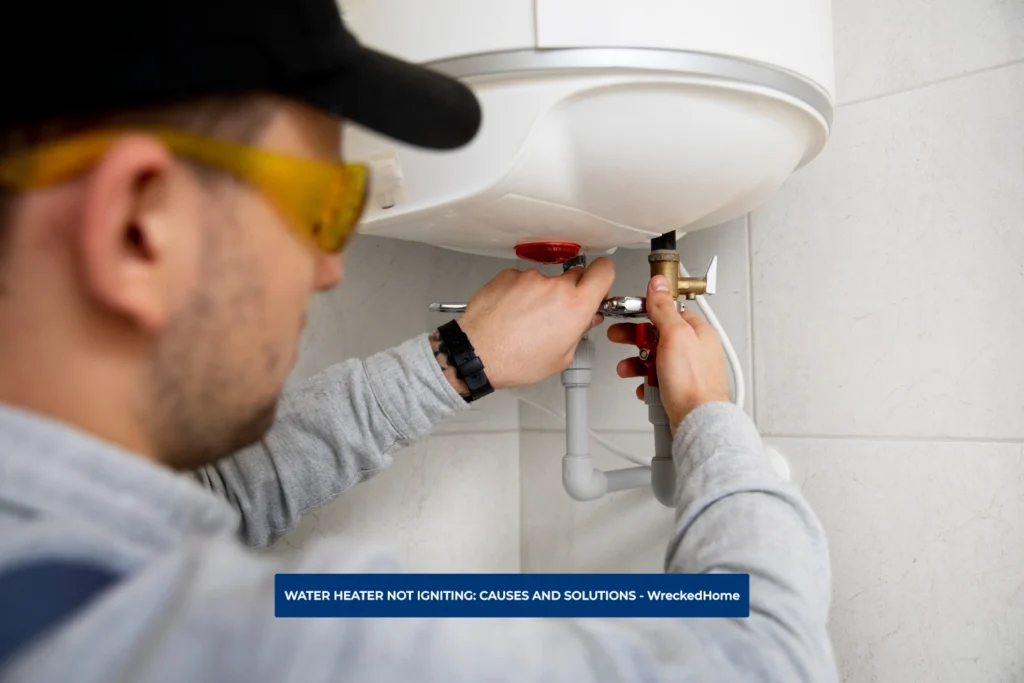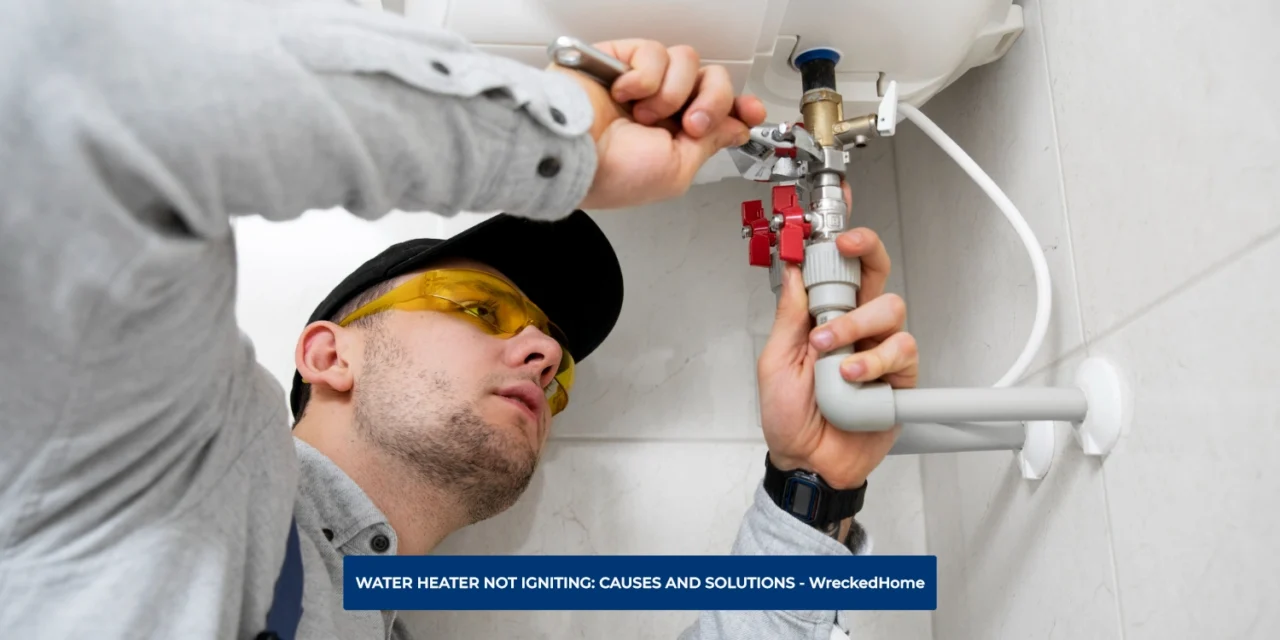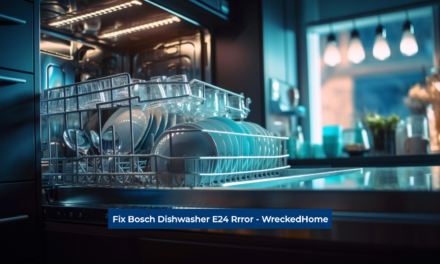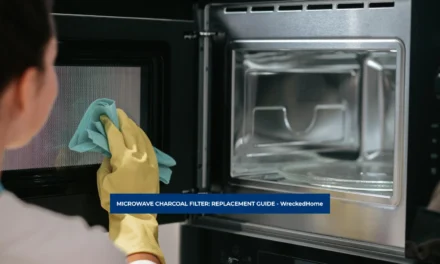Life seems easy as long as heaters, both gas and electrical, work fine. Like all other appliances cookers, washers, and dryers, heaters also stop working due to mechanical failure or power outages.
Some causes of your water heater not igniting are repairable at home while many need technicians’ help for complete solution. For your understanding, we have discussed 12 causes with solutions of why water heaters are not working or igniting. So, keep reading.
- 12 Causes And Solutions Of Water Heater Not Igniting
- Water Heater Not Igniting: Water Heater Gas Valve
- Water Heater Not Igniting: Faulty Gas Valve Assembly
- Water Heater Not Igniting: Water Heater Temperature Sensors
- Water Heater Not Igniting: Water Heater Igniter
- Water Heater Not Igniting: Draft Inducer Fan Motor
- Water Heater Not Igniting: Pressure Switch
- Water Heater Not Igniting: Water Heater Thermocouple
- Water Heater Not Igniting: Water Heater Limit Switch
- Water Heater Not Igniting: Water Heater Flame Sensor
- Water Heater Not Igniting: Water Heater Pilot
- Water Heater Not Igniting: Spark Electrode
- Water Heater Not Igniting: Incoming Power Problem
- Conclusion
12 Causes And Solutions Of Water Heater Not Igniting

To make the water heater function properly, 12 things you should check, but don’t worry, every problem has a possible solution and for that keep reading.
Water Heater Not Igniting: Water Heater Gas Valve
The gas valve is another reason for the ignition of the water heater. When the valve opens, it allows gas to enter burner and light it up. If the valve doesn’t open, gas doesn’t reach to burner and it will not lit up.
Solution
- First check that the ignition source is working fine like spark igniter or pilot light. If your heater’s ignition source is faulty, it will not generate a spark or flame necessary to ignite the gas.
- Sufficient gas pressure is necessary to open and allow gas to flow. Check the pressure of the gas valve by using a pressure gauge. If the pressure is low, it means it doesn’t overcome the valve’s spring tension and makes it remain closed. If pressure is normal, the valve opens and lets the gas flow to the burner.
If both work fine it means you have no other option than replacing the gas valve and thermostat.
Water Heater Not Igniting: Faulty Gas Valve Assembly
The gas valve assembly is an important part of the gas water heater. Gas valve assembly regulates the gas flow to heater burners. As you have already checked the ignition source and gas valve pressure in the previous point, now it’s time to move further. If both the ignition source and gas valve are functioning correctly, the gas valve assembly itself is faulty. You must replace the gas valve assembly so that you can restore proper gas flow to the burner and ignite it.
Water Heater Not Igniting: Water Heater Temperature Sensors

The water heater temperature sensor can also be called the flammable vapor ignition reset (FVIR) system. It is important because it ensures that flame vapors do not reach the heater. This is because the sensor can detect vapors. If the sensors detect any flammable vapors, it gets tripped due to which the burner also shuts down. When the burner will not ignite, the heater remains safe from potential fire hazards.
Once the sensor tripped to save your heater, it is necessary to replace it with a new one. Don’t try to only reset the sensors as it resolves the problem for some time, but don’t detect or solve the reason for the flammable vapors. When you replace the sensor, your heater will again ignite. The sensors also ensure that the safety mechanism is working and will detect and respond to flammable vapors if present there.
Water Heater Not Igniting: Water Heater Igniter
A water heater igniter is an important part of gas-fired water heaters. The ignitor ignites the gas burner and starts heating of water. If it is broken, it will not heat your water. To check if it is functioning, so the steps below.
- Check the ignition source to see whether ignitor receives electrical power. Use a multi-meter to check voltage, if it is under 120 volts, it means the igniter is getting power.
- After receiving power, the ignitor glows red-hot when you turn on the heater. If the igniter does not glow, it may be defective like having cracks, bends, or corrosion so replace it.
- Some ignitors can start work again after cleaning like spark igniters. First, turn off the gas or electricity supply, then clean the ignitor with a soft brush or compressed air.
- You can replace the ignitor, but it’s better to seek expert help or at least follow manual instructions.
Water Heater Not Igniting: Draft Inducer Fan Motor
The draft inducer fan motor draws air into the burner and then exhausts it out flue, allowing proper combustion and preventing the buildup of harmful gasses. If the draft inducer motor is not working rightly, it causes burner failure, incomplete combustion, and emission of hazardous gasses.
Draft inducer motors may stop working due to worn-out bearings. The constant use and friction of bearings make them wear down which hinders motor functioning or stops it completely. This can stop air flow, and burner will not get required oxygen for combustion.
The vacuum port detects airflow and signals the burner to ignite. If there is a clog in the vacuum port, it can obstruct airflow and prevent the closing of the vacuum switch, which leads to hindered ignition problems.
So, keep checking the bearings’ condition, clean the vacuum port, and lubricate the motor for the efficient working of the draft inducer motor. If you hear unusual noises, see reduced air flow, or see burner failure, service your motor or replace it with help of qualified technician.
Water Heater Not Igniting: Pressure Switch
The pressure switch is a safety device that closes when the air flow created when the draft inducer motor reaches a certain level. This pressure switch then sends a signal to heater’s control board to continue the ignition sequence. If the pressure switch is not working fine and fails to close, control board will not get signal and halt the ignition. If ignition starts without adequate airflow it releases harmful gasses due to incomplete combustion. So, repair or replace the pressure switch for proper functioning of hot water heater.
Water Heater Not Igniting: Water Heater Thermocouple
A water heater thermocouple is a small, metal rod near pilot light. The thermocouple is another safety device that gets heated up when pilot flame is lit, and generates small electrical current. This current keeps the gas valve open, and provides gas flow to the burner for ignition. When pilot flame is off, the thermocouple stops airflow to burner and prevents gas leakage. As the thermocouple is important for safety, they should remain in good condition so inspect them regularly or replace them when needed.
Water Heater Not Igniting: Water Heater Limit Switch
The limit switch detects water temperature; if it’s too high it will shut off the power to heater. The reasons for high temperature may be high settings of thermostat, fault in the heating element or any other part of heater.
Limit switches come in two varieties: with manual reset and automatic reset. In manual ones, you can reset switch by manually pressing button. In automatic, limit switches reset automatically when water temperature cools down.
When the limit switch has tripped, you can manually reset it. However, again check the limit switch with a multi-meter for electrical continuity.
Water Heater Not Igniting: Water Heater Flame Sensor
Another reason the water heater not igniting is the burner flame itself. The flame sensor is a spark rod near the burner that detects heat from flames and prevents the gas valve from opening and supplying gas if the burner doesn’t flame up. Thus, the flame sensor protects the heater by preventing gas from leaking into the heater and causing an explosion.
With time, the sensor gets dirty and doesn’t work causing the heater to turn off unexpectedly. Clean the dirty sensor or replace it if it is damaged. However, you should replace the whole igniter assembly for a faulty sensor when the heater does not light or ignite due to it. If your water heater isn’t working and you need a new one, read our guide about State Water Heater, Point of Use, and Navien Tankless vs Rinnai water heaters.
Water Heater Not Igniting: Water Heater Pilot
A pilot flame is small flame that remains lit up even when the heater isn’t in use. The pilot ignites the main burner, and when the pilot light goes out, the heater stops working.
Less gas flow to pilot is one of the main reasons the pilot light shuts off, which may be due to some clog in the gas line or faulty gas valve. The pilot light also goes off if it is dirty or dust or other debris builds up on it. A faulty igniter also causes pilot light to go off. You can try to relight it, but it’s better to seek expert help if it doesn’t work.
Water Heater Not Igniting: Spark Electrode
A spark electrode generates a spark that ignites the pilot light of the water heater. The spark electrode is near the pilot burner and is connected to a high-voltage transformer. The electrodes generated intermittent high-voltage sparks and sent them to light the pilot. If the electrode fails to generate a spark, the water heater will not ignite, and it means the electrode is faulty, so replace it.
The reasons behind faulty spark electrodes are
- dirt and debris buildup cause hindrance in the jumping of sparks across gap.
- Corrosion also prevents spark from crossing the gap.
- If the transformer itself is damaged, it will not generate high-voltage spark and cause water heater not igniting.
- The wire between the spark electrode and transformer may be damaged and prevent spark generation.
In all such cases where spark electrode fail to work, immediately call qualified plumber to replace it.
Water Heater Not Igniting: Incoming Power Problem
When the heater doesn’t get the right power from the power supply, it will not ignite. Supply of insufficient power may be due to a circuit breaker, blown fuse, or power outage.
Gas water heaters come with power vents that rely on electricity to operate blower assembly of heater. This assembly is responsible for drawing air into water heater and exhausting combustion gasses. When the power doesn’t reach the blower assembly, the gasses don’t combust and the burner remains shut off to keep everything safe.
Similarly, Electric water heaters require 240 volts of electricity for heating water. In case of no or less power, heating elements will not start or generate heat, thus, no hot water in results.
To detect power issues, check circuit breaker which controls the gas heater blower assembly or two circuit breakers or fuses that control electric water heater. In case of tripped or blown breakers or fuses, reset them or replace them.
Testing the power outlet is also necessary; unplug the heater and plug it in any other machine. If the machine starts it means the issue is inside heater or if it remains quiet, ask electrician to repair or replace outlet.
Inappropriate voltage may also cause issue of an electric water heater not igniting. Test voltage at the top two terminals on upper limit thermostat or at incoming power wires under access panel by using a Multi-meter. If the voltage is 240, it means the problem is somewhere else, otherwise incoming power supply is the main culprit.
Conclusion
Water heaters have many small components and a clog, fault, or damage in any of them cause a water heater not igniting. Cleaning the clogs, repairing the faults, and replacing the damaged parts make water heaters function properly again.
If you still cannot fix your water heater after troubleshooting, then call a professional. Find A Pro Near You Here!





































